
Everything in this slideshow
-
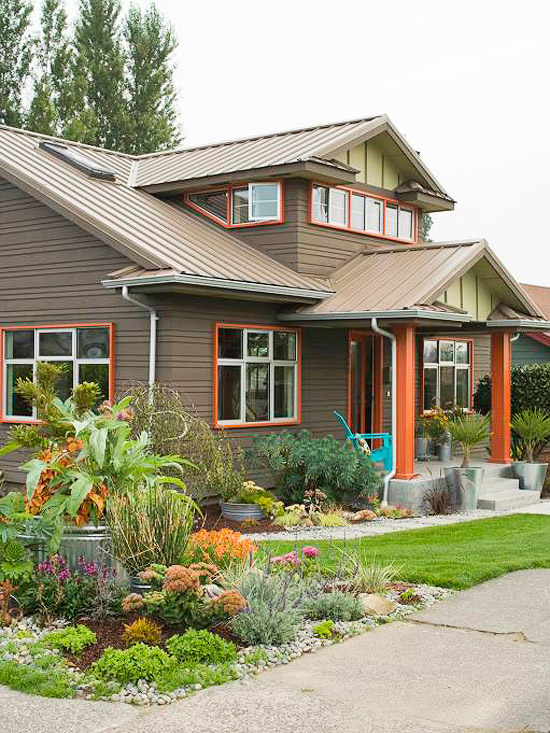
Corner Cool-Off
A pretty bed provides blooms without hogging water.
- Water runoff typically happens on sidewalks and other hardscapes. Minimize moisture waste by planting a strip next to walkways.
- A quick way to reduce water loss: Reduce the amount of grass, which requires tons of moisture, particularly during hot-weather months of July and August.
- If certain plants require a bit more water, plant them together in containers to concentrate their moisture needs.
- Very tall containers elevate plants to add height to a garden.
- The easiest way to conquer drought-prone garden areas is to plant flowers that don’t require a lot of water to thrive — lavender, for example.
- Conserve water by building your own raised bed for flowers and vegetables.
-
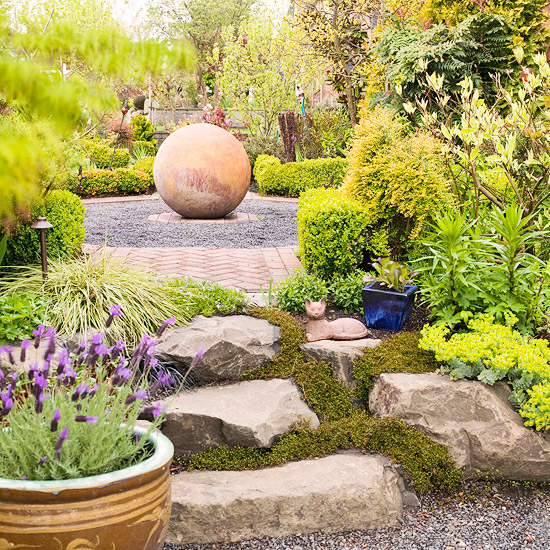
Circle Play
Hardscape elements step up to the challenge of a drought-tolerant garden.
- Groundcovers — here, thyme — provide a good way to catch water that might be lost on the gentle slope.
- Two sculptures — a whimsical cat, and an orb — offer drama in place of showy, water-needy plants.
- In any garden, but especially in drought-conscious ones, mulch is essential to conserving moisture (and it keeps down weeds).
- Many flowers supply showy blooms but require loads of water; in place of them, hardscape elements — including pavers and a series of circles — furnish visual interest.
- Once established, shrubs and evergreens, such as arborvitae, require very little supplemental water — except in times of extreme drought — and offer bountiful structure and color.
-
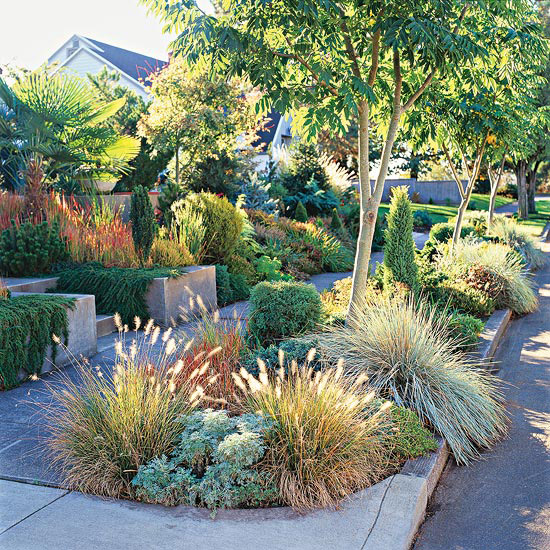
Water Smarts
Foliage plants shine in this drought-tolerant garden.
- Many drought-tolerant plants offer less-showy blooms, but make up for it with interesting foliage, such as this Japanese bloodgrass.
- The combination of grass and concrete in many curb strips doesn’t do much to stem water loss, but this planted version catches water before it hits the street.
- In place of grass, choose drought-tolerant plantings, which are more likely to prevent erosion.
- Shade, too, can be a necessary element in the fight against water loss: Plants lose a lot of moisture from evaporation on hot days.
- Grasses and artemisia offer beautiful foliage in this planted bed.
-
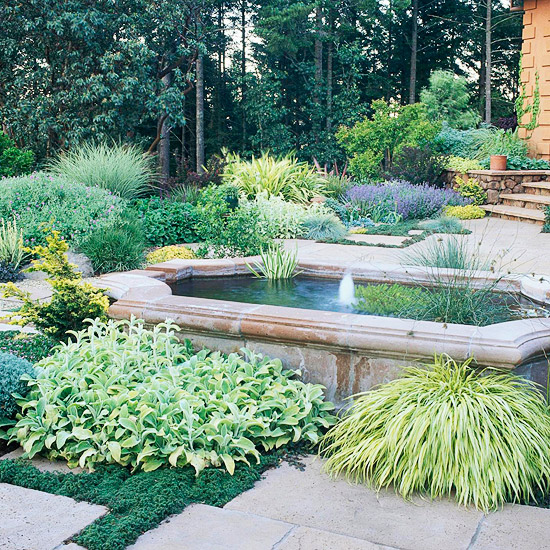
Charming Cascade
An unexpected water feature dresses up a drought-smart yard.
- A fountain may not seem like a first choice in a drought-tolerant garden, but good design can enable the feature to capture and recycle water.
- Showy foliage, including Japanese forest grass, offers dramatic visual interest.
- To counteract the warming effect of pavers, consider groundcovers to cool key areas, such as wide gaps between stones.
- Herbs — oregano and thyme, for example — are good drought-tolerant plants for a garden.
- Planted and mulched areas on a slope also provide a spot for water to soak into the ground.
-
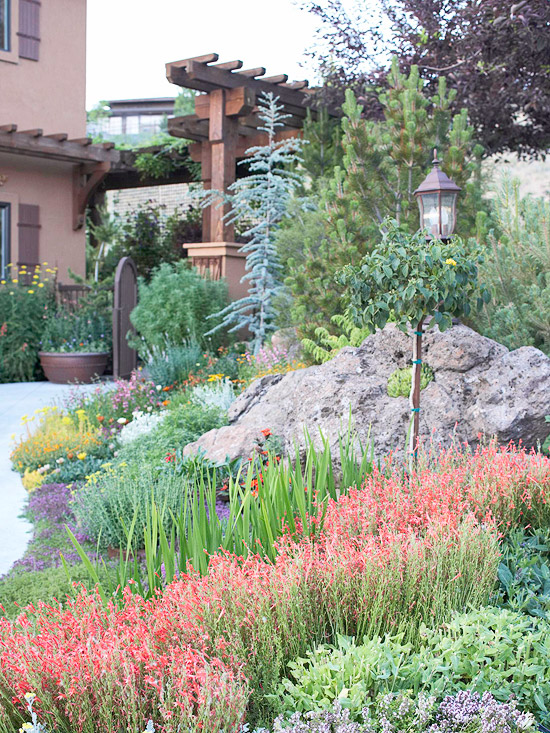
A Better Garden Bed
Water-saving strategies make gardening sense for this flowerbed.
- Showy hardscape elements, such as an oversize boulder, fill in gaps in a drought-tolerant garden by adding unexpected focal points.
- If plants with a variety of water needs are included in a garden, group those with similar requirements together, such as the lavender cotton the penstemon grouping here.
- Another way to ensure good growth for water-smart plants: Add the right amounts of soil amendments, such as a healthy dose of natural compost.
- A tall outdoor light provides accent and security to the landscape.
- Different varieties of evergreens offer structure and color.
-
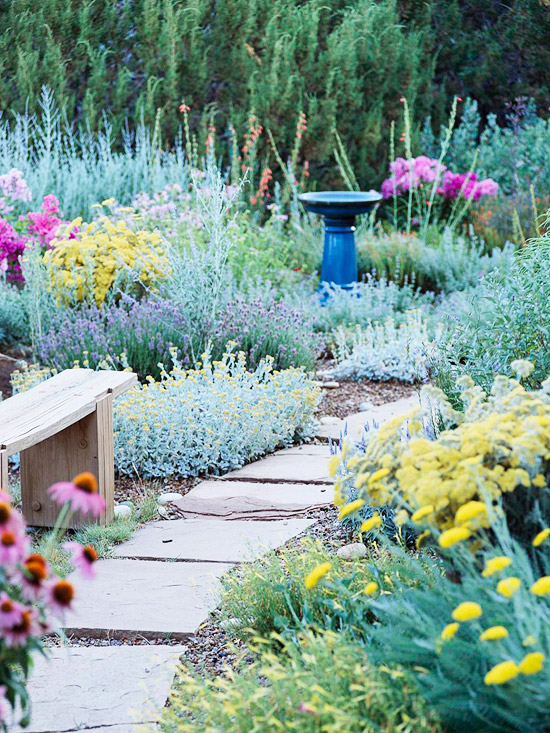
Down the Garden Path
An attractive garden bed relies on native plants.
- Research native plants, such as yarrow, which often have built-in drought-tolerant features.
- Spread 2-3 inches of mulch between widely-spaced plants; this reduces water loss and suppresses weeds.
- Install a drip-irrigation system. It wastes less water and delivers hydration directly to the plants.
- In place of mortar, a porous material between paving stones provides another way for rain to soak into the soil.
- In this garden, simple elements, including a birdbath and wooden bench, offer subtle focal points.
- See more garden path ideas.
-
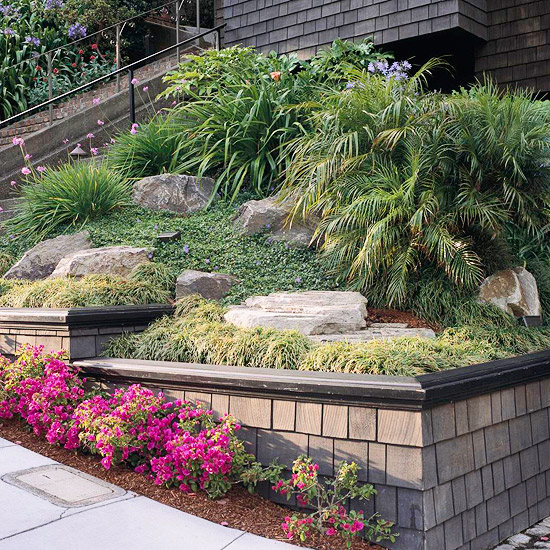
Clever Corner
A small flowerbed offers a solution to a difficult site.
- Even narrow strips of garden that aren’t planted need to be mulched, as evidenced by this border between bed and sidewalk.
- Add a raised bed with distinct borders and include plants to prevent water loss from an abrupt grade shift.
- A careful selection of boulders gradually steps down the bed, directing water to planted areas.
- Plants that require more water often require good drainage. To ensure smart water use, make sure soil is amended properly with plenty of compost.
- If drought-resistant plants such as bougainvillea need watering, schedule to water them early in the morning or late in the day to prevent water loss from evaporation.
-
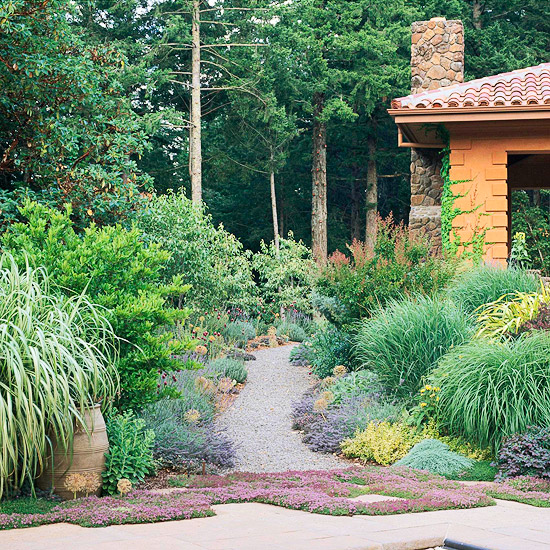
Good Grasses
An unexpected burst of color comes from a collection of ornamental grasses.
- Water naturally runs down slopes, even small ones. Creeping thyme at the bottom of a gravel path helps prevent water loss in this garden.
- Tucked unobtrusively in the landscape, a rain barrel offers an eco-smart way to recycle rainfall.
- Make pathways from a porous material, such as gravel, instead of non-permeable concrete so soil can absorb some water before it runs off.
- Ornamental grasses offer color and structure in this drought-resistant garden.
- Purple catmint and allium edge the gravel path in this flowerbed.
- Discover some of our top ornamental grasses.
-
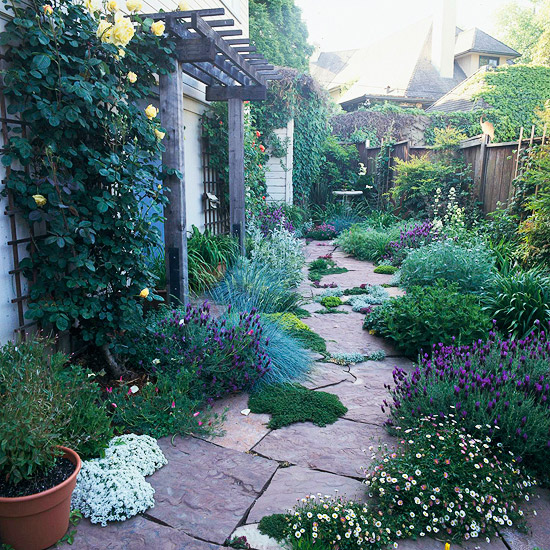
Side Swipe
A mixture of plants and hardscape elements adorns a side yard.
- Planting a drought-tolerant garden doesn’t mean eliminating high-need plants. It does mean limiting those plants to use as dramatic accents, such as this yellow climbing rose.
- A trellis decorates the home’s facade and offers a welcome hardscape element in the garden.
- Gaps between pavers provide spots for water to soak into the ground below.
- Durable lamb’s-ears offers vigorous growth from late spring through fall.
- Creeping thyme randomly softens edges of the pathway.
- Learn more about climbing roses.
- Learn more about lamb’s-ears.
- Learn more about thyme.
-
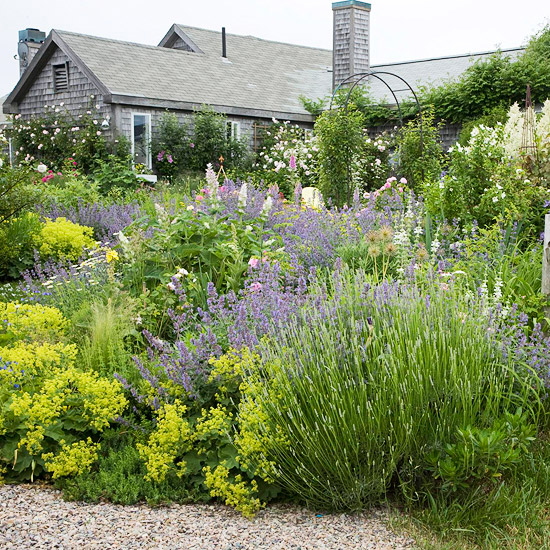
Cheery Repose
A casual accumulation of plants dresses up a garden.
- Densely planted flowerbeds help to keep weeds from sprouting (and eliminate the need for mulch, too).
- A collection of water-hardy plants, including lavender, catmint, goat’s beard, and lady’s mantle, all require minimal water to reach maximum growth.
- A metal trellis offers a bit of hardscape height and visual interest.
- To maintain the laid-back vibe of this garden, a wooden fence serves as informal edge.
- A more permeable walkway, such as pea gravel, offers another solution to prevent water runoff.
-
Drought-Tolerant Container Garden
Learn how to create a container garden that will stand up to summer’s heat.
-
